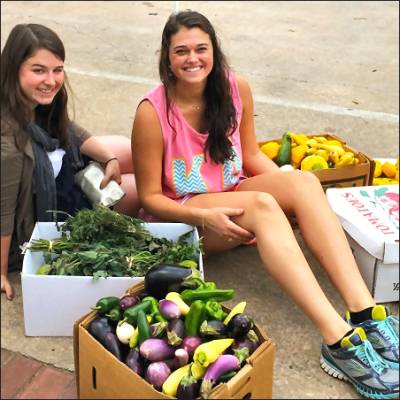By Lynette Johnson *

Society of St. Andrew gleaning volunteers at the East Chase Farmers Market in Birmingham, AL.
My grandmother began homemaking in the early years of the Great Depression, and had six growing children during the patriotic rationing years of World War II. Grandma made sure her family was well fed by growing a garden each summer and by canning and preserving the garden’s bounty for healthy food throughout the year.
Grandma grew, and her family ate, just about everything: beets, melons of all sorts, turnips, rutabagas, chard, kale, rhubarb, and on and on. Until she reached her mid-80s, Grandma kept at least a full-acre garden every year.
My mother, Grandma’s daughter-in-law, was always a “from scratch” cook, concerned about good nutrition for her family. Every meal had two vegetables, a fruit, a starch, and a meat. At home, though, we only ever grew strawberries, tomatoes, and sometimes beans in a little plot outside the back door. Mom did some canning, but most of our fruits and vegetables came from the grocery store. Asparagus and Brussels sprouts were exotic for us growing up.
Fast forward another generation: I’ve been a single, working mom for more than a decade. I have never had time or energy to get very excited about gardening or cooking, so my children grew up eating an even narrower array of fruits and vegetables than I did.
My family’s story is fairly typical. Our nation’s vegetable “vocabulary” has narrowed dramatically in just a couple of generations. Changing family dynamics, economic pressures, and cheap convenience foods have lured us away from our roots in the earth.
As the vegetable vocabulary has narrowed, cooking knowledge has decreased at all income levels. Even such basic skills as how to read a recipe are far from universal. Families struggling to get by may lack cooking equipment (pots, pans, measuring cups, working stove) and standard ingredients (anything beyond salt and pepper) to prepare even simple dishes.
This limited vegetable vocabulary is a big challenge for an organization like the Society of St. Andrew, that shares healthy food with hungry people.
If raw fruits and vegetables, fresh from field or orchard, are shared with hungry families, then those who receive them have to know what they are, know how to prepare or serve them, and have the ingredients, equipment, and time to do so.
Corn, beans, tomatoes, peaches, blueberries, potatoes—those and a few others are fairly universally familiar in the U.S. At the Society of St. Andrew, we believe that sharing these directly with folks who need good food makes a lot of sense.
We find that less familiar fruits or vegetables (like mangoes, peppers, turnips, or eggplants) are often best shared through a soup kitchen or shelter, where trained kitchen staff can prepare and serve them to clients or guests.
Expanding the vegetable vocabulary is an important topic, and one for another blog post.
For this post, let your takeaway be that Society of St. Andrew staff and volunteers do their very best every day to match the produce gleaned with the needs of the intended recipients.
With your help, we share fresh fruits and vegetables, often on the day they are harvested, and always in type and quantities that can be used quickly and without waste by the recipient.
Want to learn more about canning and preserving fruits and vegetables? Check with your local Agriculture Extension agency for classes, or visit the National Center for Home Food Preservation.
* Lynette Johnson is SoSA’s Director of Church Relations
AUG
2016

